In 4D seismic, the four dimensions are X, Y, Z and Time. To monitor a field and its production, 4D seismic technology uses two 3D seismic cubes, spaced by months or years. At the end of the 4D processing, two seismic cubes named Base and Monitor are obtained, each one representing a slightly different observation of the same geology. It will bring unbiased information, as it is an observation without any a prior data. It allows maximizing oil recovery, optimizing infill-well positioning, managing injection and offtake, and monitoring geomechanical effects.
The objectives for 4D processing are not necessarily the same as for 3D seismic. The aim is to co-process Base and Monitor data, to have a clear, 4D signal. The differences must be null in the whole cube, except for the zones where production has changed in-situ conditions (fluid displacements, compaction, etc.). The repeatability between seismic vintages is of outmost importance in production-spared areas, as it will define the degree of confidence that can be given to 4D data.
Al Khalij is an oil field that has produced since 1996, in Block 6, offshore Qatar. The Base data were acquired in 1999 by Geco-Prakla, using a single-source boat with four streamers. The full survey size is around 390 km2. The 3D data were processed three times by Geco-Prakla in 1999, by PGS in 2005, and by CGG in 2009. The Pilot Monitor for 4D purposes was acquired in 2012 by BGP, using a single-source boat with six streamers. The data are divided into two swaths, with a total size of 60 km2. This is a shallow-water area with carbonate-layered geology.
Effective multiple attenuation and de-striping were the main issue of this processing. The goal was to highlight 4D effects in such an environment. Expected 4D effects computed by the Total model were up to 30% amplitude variations and negligible time shifts. This article discusses how this 4D test has been turned into a success. It also shows examples of seismic processing issues that have had a small impact for 3D purposes but are detrimental for 4D analysis, and explain what we have learned and changed for the Al Khalij full-field 4D.
A SUCCESSFUL 4D TEST
Bruno Pagliccia, et al., presented the acquisition feasibility and early processing results of the Al Khalij 4D Pilot.1 Final 4D processing was delivered to the Total E&P 4D team during October 2013, for 4D inversion and interpretation. The 4D interpretation team showed that relevant 4D anomalies are present in the seismic pilot monitor, and that they are interpretable. Moreover, they highlighted a fluid communication pathway from a 4D dIp/Ip map that correlates with the reservoir model. This successful 4D test led to the acquisition of a full-field 4D monitor, shot during summer 2014.
Figure 1 shows Base 1999 and Monitor 2012 seismic sections and allows appreciating how much those seismic are repeatable after 4D processing. The color palette used to display seismic differences is boosted, to observe non-repeatability in the overburden; the reservoir is between the purple and red horizons. NRMS (Normalized Root Mean Square) is a standard, 4D quality control in the industry;5 it is computed over a sliding window, to estimate the repeatability in 3D. On the NRMS section, the 4D noise is at the level of other 4D in conventional environments, and the 4D signal can be observed in the reservoir interval. After Total’s 4D inversion, the computed velocity change cube is noisy, but it clearly shows a production signal in the reservoir. The Al Khalij 4D signal is more detailed in B. Blanco, et al.2
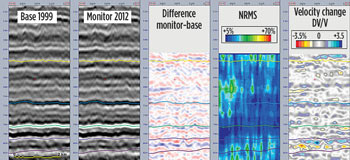 |
| Fig. 1. From left to right: Base and Monitor seismic sections, the differences between them, NRMS 4D result, and the velocity change from 4D inversion. |
|
Such results were obtained, thanks to intensive 4D QCs performed at each processing step, and for the tuning of each algorithm parameter both by CGG and Total E&P. Figure 2 shows SDR maps (signal-to-distortion ratio) computed along the processing sequence. This attribute, introduced by J. Cantillo6, is focused on amplitude non-repeatability. Since 4D signal is mainly a change in amplitude, particular attention has been given to this SDR attribute. 4D amplitude changes are more difficult to detect than 4D time shifts at early processing steps. This is unfortunate, since the authors had to choose each processing parameter without any possibility of observing 4D anomalies before migration. At some processing steps, it was necessary to push the 4D processing until migration, to observe the impact on the 4D signal.
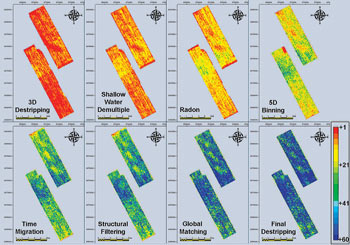 |
| Fig. 2. Overview of the 4D Al Khalij Pilot processing project with SDR maps (signal-to-distortion ratio) in the deep overburden. This SDR attribute allows appreciating the non-repeatability in amplitude, SDR = 1 is equivalent to very poor repeatability, SDR > 20 is acceptable, SDR > 50 is good. |
|
Statistics with noise characterization cross-plot (NCCP) presented by Saint-Andre, et al3, allowed validating a 4D signal during 4D processing. This 4D QC is a way to separate two kinds of 4D noises in the overburden. The first one is ambient noise, mostly random, independent from the measurement and constant in amplitude. It is linked mostly to the environment: swell noise, other vessels, tug noise, factories or the drilling platform. As this noise is independent from seismic amplitude, it is constant in this cross-plot, depicted in white in Fig. 3.
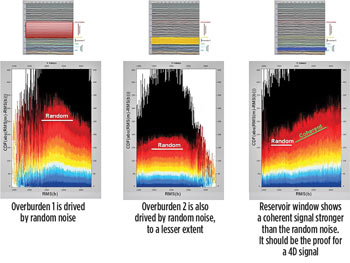 |
| Fig. 3. Noise characterization cross-plot on Al Khalij 4D pilot’s final data. |
|
The second one is the repeatability noise, depicted in green within Fig. 3. It corresponds to measurement errors that are linked to the parameters that cannot be controlled perfectly: source and streamer positions, source power variations, or streamer depths.
In Fig. 3, 4D amplitude (absolute value of the difference between Monitor amplitude and Base amplitude) is plotted as a function of Base amplitude, using a cumulative distribution function along the 4D amplitude axis. Each of the 10 colors represents a 10% probability area. It describes the conditional probability for a given Base energy that 4D amplitudes are above a certain level. This noise characterization cross-plot quantifies the probability to detect a 4D signal.
The iso-value of probability, i.e. the frontier between each color, delimits different areas of probability to detect a 4D signal. The primary purpose is that NCCP enables comparison of the slopes of repeatability noise and the level of ambient noise. It is effective, to compare different processing steps or different 4D project. In the reservoir area, if there is a 4D signal, it should appear as something coherent, like a repeatability noise. This is the case for the Al Khalij 4D pilot, presented in Fig. 3. It should be noted that this 4D QC shows that random noise is the factor that limits the repeatability of this project.
4D Seismic processing is nothing more than the co-processing of two 3D seismic swaths. The pre-processing uses different parameters for Base and Monitor, because the acquisitions have been done under different conditions. After de-multiple correction and 4D binning, i.e. the choices of the traces that will be kept for both datasets, Base and Monitor are co-processed and matched. Even during the pre-processing, the 4D QCs in time, amplitude and phase, drive the processing steps and parameters tuning.
Over the Al Khalij pilot area, the most critical issues were the following:
- The multiples attenuation, the keystone of this survey—layered geology and shallow-water bottom made de-multiple processes highly challenging;
- The shallow-water environment implies a poor, shallow seismic quality. With a reservoir buried at 800 m, there is a short overburden to be used for 4D computations and matching. This window is important for 4D processing—this is where 4D processors make the assumption that nothing happened between vintages. From then on, it is used to match one vintage on another and for numerous 4D quality controls;
- The footprint attenuation: the footprints were obvious on this data, due to the acquisition characteristics;
- The noise attenuation—especially linear noise and some on near-offsets. As shown in Fig. 3, the 4D random noise is this project’s limiting factor. Thus, a particular attention has been given to the pre-processing. Indeed, linear noise or swell noise appears as random noise on stack. As the Base shows an important 3D random noise level, the only way to reduce the 4D random noise level is to work on the pre-processing of the Base dataset.
A small impact for 3D purposes, although detrimental to the 4D analysis. Receiver motion correction during this 4D project flagged an error in streamer numbering. The impact on 3D of the reformatting is visible on Fig. 4. This had a small impact at the end of the 3D processing but implied important anomalies on 4D QCs.
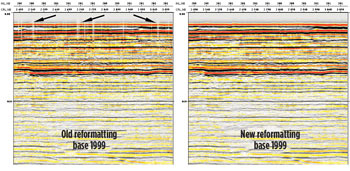 |
| Fig. 4. Stack of a sail line, before and after reformatting. |
|
Another acquisition anomaly that is detrimental to the 4D analysis was detected. A misfiring gun that was supposed to be deactivated from observer logs was firing randomly after the source shot, creating some random noise on a common channel.
As the water column thickness and velocity changed between Base and Monitor surveys, multiples did not repeat. 3D surface-related multiple-elimination (SRME) results looked good in 3D for both Base and Monitor. The 4D results were less obvious, with a good behavior below the reservoir but degradation above and within the reservoir of 4D difference and attributes. It is known that adaptive de-multiple processes degrade the 4D repeatability, but the artifacts created by the 3D SRME existed to the extent that we cancelled it for the 4D pilot project. For the 2014 full-field processing, an iterative approach of 3D SRME may be tested. 4D adaptive subtraction will be tested further for 3D SRME, with a simultaneous subtraction of Base and Monitor models minimizing both outputs, as well as the 4D difference.
Some potential positioning problems were detected. Offset Quality Control showed two sequences that might have shifted offsets between Base and Monitor. Offset QC is a relative quality control between vintages. It consists of the picking of residual curvature vs. offset after Normal Move Out correction. The difference of residual curvature vs. offset can be fitted linearly, where the gradient is related to offset shift between vintages, and the intercept is the time shift between vintages. According to the acquisition report, source positioning issues might have happened, yielding to bad offset on Base. A source repositioning of about 3.3 m, shift, has been performed for two sequences of Base, visible on Fig. 5.
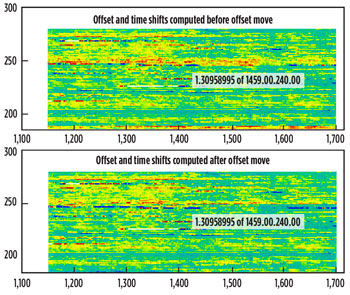 |
| Fig. 5. Offset and time shift maps before/after offset move. |
|
To conclude, the 4D analysis is so sensitive, that it highlighted many oversights in the baseline survey acquisition and pre-processing. Thanks to a thorough comparison between different vintages acquired over the same area, it is possible to find out how to correct it.
PREDICTION OF 4D NOISE
To get the most value out of the future Al Khalij 4D full-field seismic, we wanted to predict the repeatability during the acquisition. Based on Total E&P’s original method for predicting 4D noise from J. Cantillo,4 we figured out how to predict in such an environment, the 4D repeatability with the Base data of 1999 and the geometry of the Monitor acquisition (∆SR = distance between sources + distance between receptors). As presented in J. Cantillo’s paper, the crucial geometrical parameter controlling geometric non-repeatability seems to be the navigation, azimuthal differences coming second. However, as shown with Fig. 3, the Al Khalij 4D repeatability limiting factor is random noise; so it has to be taken into account. We designed, specifically for this project, a statistical operator that spots, in the base dataset, the amount of random noise, to predict what will be the amount of 4D random noise.
Since we know from 4D seismic interpretation what level of 4D noise is acceptable over Al Khalij, it is possible to know which navigation specifications will compromise the future full-field 4D analysis. Moreover, it will guide 4D processing by showing which areas require specific attention. Figure 6 shows how robust the method is by comparing SDR (amplitude non-repeatability), which is measured between Base and 4D pilot Monitor and predicted SDR, estimated with Base data and Monitor navigation data. Computation is done before binning, because the following 4D processing steps would have too much impact on 4D noise. Total will implement this technology onboard in the near-future.
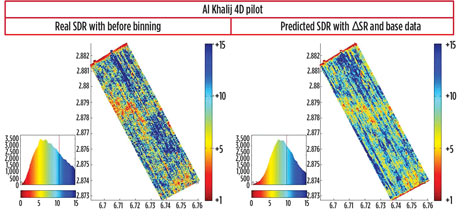 |
| Fig. 6. Southern swath of Al Khalij 4D Pilot. SDR computation between Base and Monitor before binning on the left, Prediction of SDR with Base data and Monitor navigation data (∆SR) on the right. |
|
INTERPRETATION
A 4D interpretation was performed on the results of the processing in six months with a 4D Warping step followed by a 4D acoustic impedance inversion and calibration. This permitted the delineation of pressure, saturation and gas exsolution effects. Figure 7 illustrates an example of saturation effects, as observed from the 4D relative acoustic impedance map at a reservoir level. Total observed that maps of relative impedance changes (left) compare well with geologic net thickness in the reservoir (right).
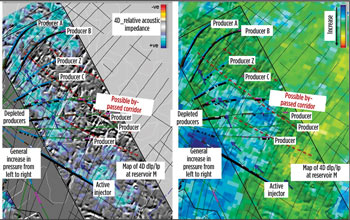 |
| Fig. 7. Fluid communication pathway from injector to producers, using 4D relative acoustic impedance at reservoir level. |
|
An active injector injects from the south in an area with good petrophysical properties, and there is an up-dip evolution of injected water towards depleted producers preferably through areas with higher net thickness. Also, by-passsed corridors are highlighted showing areas with very good petrophysical properties, but relatively low 4D signal. The authors infer the presence of lineaments that could be fluid transmissibility barriers thus creating a heterogeneous water sweep profile from west to east. These areas could be targeted for future well development to increase productivity in declining producers.
PREPARING THE 4D FULL-FIELD SURVEY
Following the Al Khalij 4D monitor pilot acquired during summer 2012, a 4D monitor has been shot in full-field scale during summer 2014. This 4D Monitor aimed to repeat the Baseline 1999 survey (388 FF km²), in water depths ranging from 30 m to 60 m. One of the lessons learned from the processing of the 4D Pilot 2012 was that the lack of near-offsets was detrimental to the de-multiple process efficiency. The nearest inline offset acquired in 2012 was 125 m, due only to operational limitations, compared to 105 m achieved during the Baseline acquisition.
In 2014, Total E&P worked with the seismic contractor on the front-end design, and a minimum inline offset of 70 m was finally implemented during the seismic operations. Special attention was also given to 4D positioning repeatability, to achieve better results than in 2012. The baseline navigational data were analyzed by a third-party contractor, and the pre-plots were created, based on the baseline source positions. Vessel steering was performed to fit, as much as possible, the source pre-plotted position. Feather matching was also considered onboard, to build the shooting plan on a daily basis.
Even if the current regime was not predictable at all times, and slightly different from the 1999 Baseline acquisition, the 4D positioning repeatability achieved during Monitor 2014 is considered of good quality. Overall, we tried to enhance each processing step or parameter that will be used for this 2014 4D processing. We performed a reformatting of the Base dataset, to correct some navigation merge oversights. 4D de-multiple has been tested on other projects, and we expect to use this experience over the Al Khalij 4D data.
CONCLUSION
The Al Khalij 4D Pilot project’s purpose was to show that a 4D signal can be extracted in an offshore carbonate environment. It was achieved, thanks to a well-managed 4D acquisition, plus careful 4D processing with intensive and dedicated quality controls, followed by a 4D interpretation within an integrated team. This project also gave us a first 4D experience in such a carbonate context, increased the confidence we have in carbonate fields monitoring, and prepared us for the 4D Al Khalij full-field shoot in summer 2014.
This experience will accelerate the processing, and final data will be delivered earlier for 4D interpretation. As the value of 4D data decreases with time, timing is fundamental. The highlighted oversights of the 1999 dataset and some 4D issues over Al Khalij will increase turnaround time and improve data quality. Moreover, along with acquisition time, we also broaden our experience in 4D de-multiple with other projects, to be ready for the more challenging full-field project. 
ACKNOWLEDGMENTS
The authors would like to acknowledge Phuong-Thu Trinh for her participation in the prediction of 4D noise, as well as Philippe Solans, Kailesh Patel, Emilie Renoux and Cyril Saint-andré for their contributions and support to this article. We also want to thank Total E&P management and Total E&P Qatar for the permission to publish this article.
REFERENCES
- B. Pagliccia et al, “From feasibility to processing: A time-lapse seismic experiment on Al Khalij field, offshore Qatar,” SPE paper 17582, presented at the 2014 International Petroleum Technology Conference, Doha, Qatar.
- B. Blanco et al, “4D seismic processing pilot offshore Qatar,” SPE paper 172035, presented at the 2014 ADIPEC, Abu Dhabi.
- C. Saint-Andre et al, “Innovative QCs for more effective 4D processing,” presented at the SEG 2012 International Exposition and 82nd Annual Meeting.
- J. Cantillo, Total E&P, “On the prediction of repeatability noise in time-lapse marine surveys,” presented at the SEG 2012 International Exposition and 82nd Annual Meeting.
- Kragh and Christie, “Seismic repeatability, normalized RMS, and predictability,” The Leading Edge, vol. 21, no. 640, July 2002.
- J. Cantillo, Total E&P, “A quantitative discussion on time-lapse repeatability and its metrics,” presented at the 2011 SEG Annual Meeting, San Antonio, Texas.
- Calvert, R., “4D technology: Where are we, and where are we going?” Geophysical Prospecting, 53, no. 2, 161–171, 2005.
- Calvert, R., “Insights and methods for 4D reservoir monitoring and characterization: Distinguished Instructor Short Course,” SEG/EAGE Distinguished Instructor Series No. 8, 2005.
|









